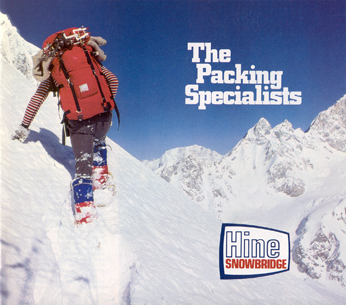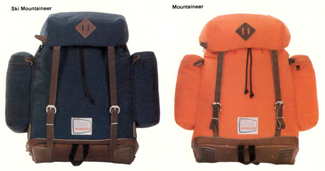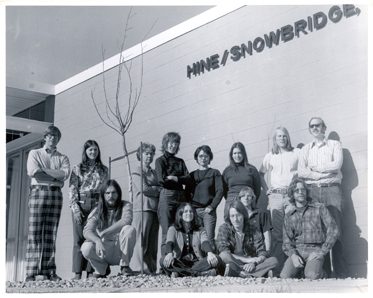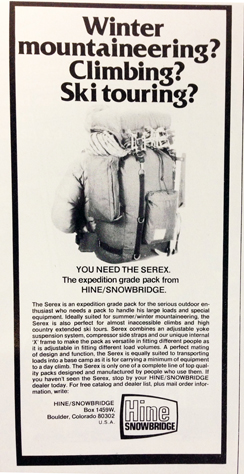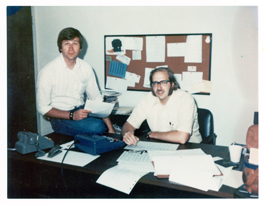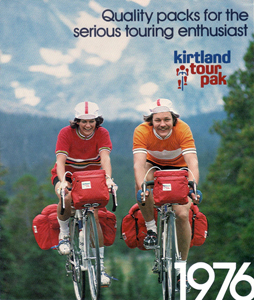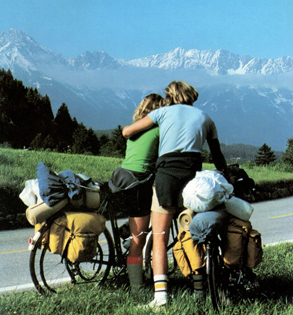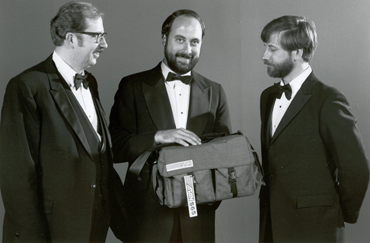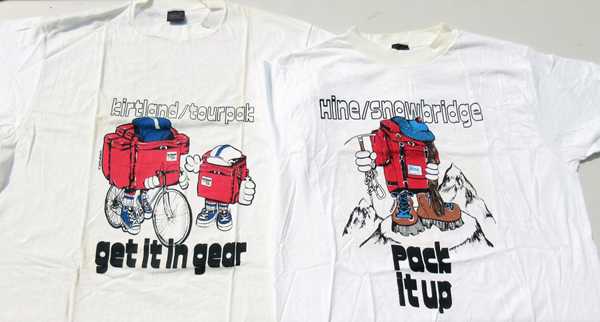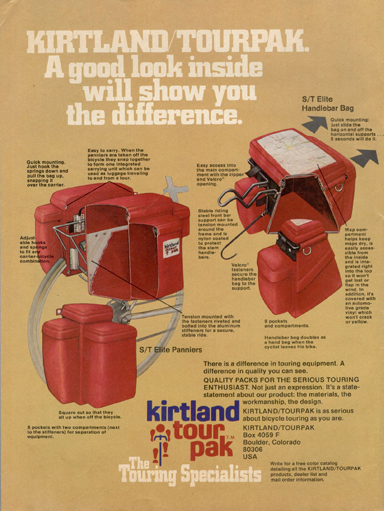Introduction Hine/Snowbridge, Inc designed, manufactured, and nationally distributed high-quality sewn pack products during the period from 1972 through 1986 in Boulder, Colorado. Our product lines included Hine/Snowbridge backpacks which were used to climb the highest mountains in the world, Kirtland (formerly Kirtland/Tourpak) bicycle packs which were literally pedaled around the world and which in the early 1980’s had a 40% market share of all bicycle packs on the road in the U.S. during the bicycle touring boom, and Atan camera packs which became a pack of choice for National Geographic and White House professional photographers and were chosen by NASA for use on the Space Shuttle early in its program and which flew on all missions till the end of the Shuttle program in 2011.
Founding The company was founded by my brother Greg and myself in June, 1972. We’d grown up in the Northeast where we skied regularly as children in New England and where we’d attended summer camp in New Hampshire and thus developed an appreciation for outdoor activities. In the summer of 1970 we’d camped and backpacked our way from California north through Washington State and the Canadian Rockies then south through Montana, Wyoming and Colorado in Greg’s VW microbus. Starting in the mid 1960’s we’d both attended the University of Colorado (Boulder) and I graduated with a degree in Business Administration in 1969 and Greg a couple of years later with an Environmental Biology degree. By 1971 Greg was working as a seasonal ranger for the National Park Service (Mt. Rainier and Yosemite) and I was the computer operations manager for Alpine Designs (formerly Alp Sport), a rapidly growing Boulder manufacturer of backpacking and skiing related recreational products founded by industry pioneer George Lamb but which had recently been sold to a “mini conglomerate” named General Recreation, Inc. which was gobbling up small to medium size recreational companies. Sales of backpacking and camping products were being driven by the post WWII baby-boom generation as well as the introduction of new nylon-based fabrics which were lighter weight, stronger, and more water repellent than the canvas and cotton-based materials they replaced. From my vantage point in the Alpine Designs computer room I observed the challenges of manufacturing and distributing such products and my business degree provided some insights as to how to do it better. In 1972 I was laid-off when General Recreation consolidated all of its multiple-company computer operations on the East Coast and Greg was coming to the end of a Park Service seasonal commitment. We got to talking and decided that perhaps it might be fun to start a manufacturing business making recreational equipment as it fit our combined backgrounds and the market was rapidly growing as the baby-boom generation came of age. We didn’t have a lot of money to invest, just of lot of youthful energy and willingness to work hard. So, as a means of spending as little as possible in June of 1972 we rented a couple of second story rooms in a somewhat dilapidated (and soon to be condemned) downtown Boulder, CO building to get started. Early on we decided to specialize in packs as a means of not spreading ourselves to thinly and making sure we could deliver the best quality product possible. We spent the next year designing a line of day packs, identifying vendors and suppliers of raw materials and machinery, and learning to sew and assemble packs. During this period it became apparent what rolls Greg and I would play as the company progressed. I’d always enjoyed designing things and had a year of engineering early in college so I ended up as our primary designer (though the later 1970’s) and Greg naturally gravitated toward sales and marketing type work. This division of responsibility worked well over the years and day-to-day Greg handled sales and marketing functions and I worried about design, financing/accounting, manufacturing, computer systems, and general management as Greg would be out of town a lot performing his duties in the coming years. Hine/Snowbridge Day Packs By late spring 1973 our line of day packs was ready to manufacture and sell so we relocated to a larger space where we could keep a staff of about 5 busy manufacturing our products. Greg started calling on possible dealers. Our first dealer was a small just opened retail store in Boulder named Neptune Mountaineering started by well-known climber Gary Neptune. (His store is still in business in 2021 thought no longer owned by Gary.) Other dealer openings soon followed and our sale began to grow rapidly as we added more products to our line and opened more dealers.
Probably our most popular day pack model over the years and certainly the most iconic was our Mountaineer model and its companion model the Ski Mountaineer. Its design was an improvement on a model sold by Alp Sport (Alpine Design) which in turn was an improvement on an old established European design. It’s considered by many old timers to be a classic. Today I still use my 1975 vintage Ski Mountaineer as my primary day pack when hiking.
About Our Dealers A few words about our dealers which applied to all of our product lines over the years: We always wholesaled primarily to “specialty shops”, dealers who specialized in only one or a few activities such as backpacking, skiing, bicycles, cameras, etc. and which provided a high level of customer service since our high-quality products often required a trained and knowledgeable sales staff. These dealers tended to be locally owned though there we a few regional chains. We didn’t sell to large retailers such a Walmart. We did however develop ongoing relationships with some large national specialty outlets (often in the mail-order business long before the days of computerized online shopping) such as REI, Eastern Mountain Sports, and LL Bean though the majority of our sales were always to a large number of smaller retailers. ---------------------------- As sales took off in 1973 we began to explore where we could expand our products line offerings and establish niches without as much competition as was the case with day packs. We found two niches which would serve us well in the coming years, Internal Frame Backpacks and Bicycle Packs.
Hine/Snowbridge Internal Frame Packs External (aluminum) “Frame” packs had been popularized in the late 1960’s by companies like Kelty and had a well-established market. (We sold external frame packs in the late 1970’s and early 1980’s to round out our product line but this was never a strength for us.) Instead, we made a name for ourselves in a new specialized area that became known as the Internal Frame pack. A Kelty style frame pack employed a rigid frame to transfer the carried weight to the hips. This worked great for easy trail hiking but became a problem when the hiker left the trail and encountered less stable terrain where upper body movement became necessary for stability. A rigid frame wouldn’t allow this. The solution was a pack with an internal somewhat flexible frame to transfer the weight to the hips while at the same time allowing some upper body flexibility and movement. It was a compromise but worked well for off trail applications in rock climbing, mountaineering, skiing etc. where a large pack carrying capacity was necessary. Internal frames became the strong point in our Hine/Snowbridge line of backpacks and over the years we were a leader in advancing the design and usability of these. Our prime competitor in this niche area of packs was Lowe Alpine Systems and over the years we went head-to-head with them advancing the technology and popularity. Our Internal Frames became well known with off-trail enthusiasts and were carried to the top of the highest mountains in the world. We offered several models of internal frames but our most popular model over the years was the Serex introduced in 1975. Over the years our primary competitors in backpack categories included Lowe Alpine Systems, The North Face, Sierra Designs, JanSport, and Wilderness Experience among others. ------------------------------
During this period Canada had a huge import tax on recreational equipment intended to discourage imports and encourage domestic production. Because of this some U.S based manufacturers set up Canadian subsidiaries or licensed Canadian companies to manufacture their products. In the mid 1970’s we licensed a startup company there to make our backpacking and bicycling products for the Canadian market. It was named Seratus which was a play on the words Serex (our pack model) and the “serrated” saw tooth like mountains in the Canadian Rockies. We provided them with our designs, some raw materials they couldn’t get elsewhere, and manufacturing methods training and they paid us royalties on their sales. This arrangement worked well for a number of years.
Kirtland/Tourpak Bicycle Packs
Greg had been a bicycle enthusiast before we started the company so in the early 1970’s we took note that a new form of recreation was developing which became known as Bicycle Touring where a rider peddled cross country staying in motels or camp grounds. This required carrying everything on the bike needed for multiple days on the road including camping gear. When we started the company this market was so small that the only way for a serious bicycle touring enthusiast to purchase suitable packs was via mail-order as there were no local retail dealers selling the packs they needed. In 1973 we were asked to make of a limited production run of bicycle packs for a tiny mail-order company and this gave us the idea that perhaps we could sell “Panniers” (French for saddle bags) and Handle Bar Bags through our growing dealer network. The concept seemed reasonable since, while someone would surely buy their bike from a bicycle shop, they would need to buy their camping equipment (tents, sleeping bags, camp stoves, etc.) at a backpacking shop. Where would they buy their bicycle packs? As with all of our products, we set about improving the design of existing bicycle packs (and over the years were issued 6 patents on our technology) and in 1974 started selling a few through our backpacking dealers. We chose to use the brand name Kirtland/Tourpak (Kirtland being old family name) for our bicycle pack line since we correctly predicted that we’d be selling into a different market from our backpacks. The name was shortened to just Kirtland in the early 1980’s. Kirtland packs were the highest quality and price available so to compete in the mid-priced market in the early 1980s we introduced the Pursuit line of bicycle packs so we could appeal to a wider market segment.
We experienced an interesting phenomenon as our bicycle pack sales exploded. We noticed early on that our sales of bicycle packs to backpack stores occurred only in a few communities around the country where apparently there was a local interest developing in bicycle touring as a form of recreation. And soon we started getting calls from bicycle shops in those communities who wanted to carry our bicycle packs because customers were asking for them. Over time sales into the bicycle industry far exceeded those to backpack dealers but it interesting that bicycle pack sales got their mainstream start in backpacking stores. Sales grew rapidly and surviving dealer lists (provided with our catalog to those requesting them in the days before the internet) show we had 25 bicycle pack dealers in 1974 in 4 states. A year later in 1975 we had 340 dealers in 43 states. By the end of the decade our number of bicycle pack dealers numbered in the low thousands. As sales skyrocketed competition soon developed. Our primary high-end competitor was Eclipse and a strong mid-priced one was Cannondale. We were soon attending bicycle industry trade shows and our sales reps were calling on bicycle shops all over the country. In the early 1980’s Bicycling Magazine did a reader survey which showed that we had a 40% market share of bike packs owned at a time when almost every bike seen on the roadways was carrying a pack of some sort. In 1984 Greg produced a 21 minute training and promotional video for our bicycle packs titled The Kirtland Experience. It also contains background information about our company and can viewed on YouTube here: The Kirtland Experience
I suppose we can take credit along with other entrepreneurial start-up companies that entered the adult bicycle market around this time (including Specialized which popularized the off- road bike, Cannondale (bikes and bags), Trek which made high end adult bicycles, Avocet, and Blackburn for forever transforming the bicycle industry. Before the early 1970’s the bicycle market was old and stodgy. It had been around for more than a century, was very set in its ways, and its customers were primarily children and others that needed short distant basic transportation such as college students. The concept of riding a bicycle as adult recreation really didn’t exist yet. It took the baby-boomers and companies like us to create the Adult Recreational bicycle movement which, while the touring and bicycle bag components have largely disappeared, is still strong today with millions of adults sport riding for recreation and exercise.
Atan Camera Packs (“Bags”) Backpacks and bicycle packs were (and still are) largely a seasonal business with the vast majority of sales occurring in the warm months in the northern hemisphere. This created challenges in keeping our factory running at optimum capacity and efficiency year around. So, we looked for something to counter balance this seasonality and in the later 1970’s decided that camera bags looked like a good solution as the majority of high-end cameras were sold around the Christmas holiday season with customer purchasing accessories into the winter months. Expensive SLR (Single Lens Reflex) cameras were selling well to baby boomer and, along with their accessory lenses, flash units, etc.), required a good quality camera bag to haul them around and protect them. Camera bags used much of the same materials and production methods as our existing products so were a good match for counter seasonal expansion. We studied the market and designed and launched a line of high-end camera bags under the Atan brand name. We were fortunate to be able to hire an experienced photographic industry marketing/sales specialist as our Atan brand manager and he quickly had us opening dealers around the country and gave us instant credibility. Our camera bag designs weren’t as revolutionary in their field as our Internal Frames and Bicycle Packs were in theirs but sold well and quickly became a bag of choice among White House and National Geographic Society photographers. In the early 1980’s NASA chose us to design and manufacture multi-use camera bags for the new Space Shuttle program. We made about 80 specially designed bags for them, perhaps the only camera bags ever manufactured from specially made fireproof fabric and likely the most expensive soft-sided camera bags ever built. I recently learned that these bags flew on all Shuttle missions from the early 1980’s till the program was terminated in 2011. While the NASA bags didn’t bring in a lot of revenue, the contract was a real feather in our cap. Interestingly and for marketing reasons, these bags carried the Kirtland brand label, not the Atan, though they were largely Atan technology. Growth Overview By around 1983 Greg and I were operating out of an almost 30,000 square foot facility in Boulder, had about 130 employees locally and around 15 sales representatives around the country, and were selling to around 3,000 active dealers in our 3 market areas. In a little over a decade we’d gone from just the 2 of us to managing a huge bureaucracy dealing with everything from design, to manufacturing, to financing, to personnel issues, to advertising to name just a few functions we supervised.
In most previous years our sales at least doubled the previous year’s, sometime more, as we added new products and opened more dealers. Every year we required more space and thus moved into larger facilities or added subsidiary locations. Managing the growth was always a challenge as systems, manufacturing methods, management structures, etc. that worked before quickly needed to be updated and changed to deal with the added volume. The only constant was change from one year to the next. We managed to fund our growth internally so never had to sell stock in the company. We did borrow heavily from banks on seasonal lines of credit to finance keeping the factory running and to build inventories during the slow sales seasons. During the 1970 and 1980’s we were one of a number of well-known highly visible recreation-oriented companies that formed and operated in the Boulder area. Others included Holubar, Gerry (camping equipment), Frostline and Altra (sewing kits), Camp7 (sleeping bags), Hanson (ski boots and skis), Pearl Izumi (bicycle clothing) and Lowe Alpine Systems (packs). While most of these companies are no longer around, Boulder is still the home of many newer recreation-oriented companies. Company Innovations Over the years as we were making product innovations in our consumer markets we were also innovating internally and with our dealer network. Computerization Due to my interest in and experience at Alpine Designs with computers we became an early adapter of what was known as the “mini-computer” which was just becoming available to small businesses in the days when most computers were huge IBM type “Mainframes” in use by large companies. In 1977 we purchased such a computer which filled an office size room and had one of the first “disk drives” available to small business. (This was long before the personal computer appeared and when only a small number of small businesses were computerized.) Since such computers were new there was almost no “off the shelf” software available specialized enough to run our business so we had to design and write our own. I wrote the specifications for our wholesale distribution system and supervised 2 programmers for a year and then debugged the software before it replaced our manual systems. This included finished goods inventory, order management, shipping, invoicing, accounts receivable, and sales tracking modules. The transition went smoothly and I moved on to writing the specifications for our manufacturing control software where I again supervised the programmers and even wrote some of the code myself. This project included raw materials inventory control, a piecework pay system tied to material usage, manufacturing scheduling, and material requirement planning to efficiently order and schedule raw material purchases. This system went live in the early 1980’s and immediately significantly increased our manufacturing efficiency. Those in a position to compare us to other similar companies gave us credit for having one of the best and most sophisticated computer systems anywhere for a company of our size at the time. Sales Methods
We can take credit for introducing the bicycle industry to a sales method which we’d learned and used in the backpacking industry. This was the concept of the Pre-Season Order. In a seasonal business manufacturers need to start making product long before the retail sales season starts to build inventory to insure delivery. This put the manufacturer in the position of having to guess long in advance what dealers were going to buy the next year which could be risky. So, the ski industry in the 1960’s had developed the strategy of asking dealers to place orders for the next year before the currently season was even over so they could plan their production based on actual orders. This concept was used and expanded upon in the backpacking industry (which shared many dealers with the ski industry due to the counter seasonality). During the days of fast growth and limited supply in backpacking, dealers at times couldn’t get product when they wanted it so the concept of insured delivery if they committed to ordering early appealed to them. Additionally, companies (including us) would ship pre-season orders long before the season started giving the dealer an extended period to pay for the product. For example, we’d ship product to a dealer say in February that they wouldn’t have to pay us for till May. The dealers liked this because it insured that they have product to sell when the season arrived and we were financing them. This method also created a huge financial benefit for us and others in the industry. To build inventory in the slow season we needed to borrow heavily from banks on seasonal lines-of-credit. Borrowing requires collateral in the form of assets pledged in case the loan couldn’t be paid off. In our case banks would use as collateral only 50% of the manufactured cost (not wholesale price) of our finished product inventory. On the other hand, 80% of accounts receivable from dealers could be used as collateral. Thus, by shipping orders to dealers “pre-season”, even with long payment terms, significantly increased the amount of money we could borrow to make product. This was a financial strategy that helped fuel our growth. The concept of pre-season ordering was unknown in the bicycle industry till we successfully implemented it there. Other companies followed. And our sophisticated (for its day) computer system was very useful in all of our markets in helping our dealer write such orders. We, unlike most suppliers in our 3 markets, had computerized printed reports that we could provide to our dealers which showed what they had purchased over the past year by month, product, size, color, etc. Our dealers loved these reports since in those days before mass computerization most weren’t sophisticated enough to know what they had purchased in the past as an indicator of what they might need to order in the future. Employee Relations In the early 1970’s the vast majority of employers still had strict employment practices regarding things like work hours, sick days, vacations, etc. The standard was the 5-day 40-hour work week. We were an early adapter of a different schedule which was voted on by our employees and regularly continued. We’d work longer hours Monday through Thursday and then only the morning on Friday’s. Our employees liked this because it gave them a leg-up on the weekend each week. Also, Friday afternoon became a time when they could schedule personal appointments (such as with doctors or dentists) without having to take non-paid time off, something that benefited both the employee and the company. Many companies of the day had paid-sick day policies which typically required an employee to actually be sick to qualify. We didn’t feel that an employee should have to lie to us about being sick to get a day off so we instituted a “Bonus Day” policy where hourly employees could take earned days off for any reason (with appropriate coordination with their supervisor). Flexible employee practices of this type are common today but in the 1970’s we were on the cutting-edge of establishing them. The Mid-1980’s Around 1984 things started to change rapidly and growth started to level off and/or began to decline significantly in all 3 of our markets. The biggest common cause was that the baby-boomers, who had fueled our growth in sales during their high school and college years, were now getting married, having families, and investing heavily in mortgages and babies instead of recreational activities. Also, seriously affecting the bicycle industry was the fact that the memory of the Middle East oil embargos of 1973 and 1979 were disappearing farther in the rear-view mirror and the price of gas was coming way down making bicycling of less interest to consumers as an alternative to the automobile. Effecting our Atan camera bags was the problem of massive overproduction of SLR cameras by the Japanese for the societal need to maintain full employment. This significantly cut the price of high-end cameras which in turn effected the price perception of what a customer was willing to pay for a bag.
At the same time sales were declining the manufacture of sewn products in this country started quickly moving “off-shore” to other counties where labor costs were much lower and as the infrastructure overseas was rapidly developing to make our type of recreational product. It quickly became apparent that to remain price competitive we would need to move our manufacturing offshore which would completely change how our business was structured and managed. Declining sales combined with the challenge of having to move manufacturing offshore caused Greg and I to reevaluate our interest in continuing in the business. Additionally, after a decade and a half of long work weeks and few vacations we were both “burned-out” and ready to take a break. So, we first sold the Atan product line to a camera industry importer and in late 1986 sold the Hine/Snowbridge and Kirtland brands to a Connecticut company with experience importing similar but non-competitive products that was looking to expand its U.S markets. We kept the Hine/Snowbridge, Inc corporate shell but changed our corporate name to HS Industries, Inc. so as not to interfere with the Hine/Snowbridge brand name which we no longer owned. For a time after the sale I continued working to wind things down in Boulder by shutting down our facility and collecting receivables from our dealer network while Greg spent much of his time in Connecticut bringing the purchaser up to speed regarding sales and marketing issues and insuring a smooth transition of our dealer network. For various reasons over which we no longer had control, all 3 of the brands we built (Hine/Snowbridge, Kirtland, and Atan) would cease to exist within a few years of when we sold them. HS Industries would continue in business till 2007 under my and Greg’s ownership and would engage in a number of different activities including acting as import agent for recreational products, consulting, and product development not associated with the recreation industry. Links Click Here to download catalogs.
In March of 1978 the publication Backpacking Journal published an article about the company after chatting with Greg and I. Click here to download and view this article. Gear Trends magazine interviewed us and did a write-up about Hine/Snowbridge and the Hine brothers in their Winter Outdoor 2008 issue as part of their recurring series titled Industry Trailblazers. Click here to download and view this article. In 1984 Greg produced a 21 minute training and promotional video for our bicycle packs titled The Kirtland Experience which took advantage of the then relative new Video Cassette Recorder (VCR) technology just becoming widely available. Our dealer could rent or buy a copy of the video for showing to consumers in their stores and/or for employee sales training. Click here to download The Kirtland Experience (.mp4). Or view it on YouTube at https://youtu.be/CABZO_okEa8 . I still occasionally see Hine/Snowbridge packs on the trail when I’m hiking and Greg occasionally sees Kirtland bags while cycling. Our packs appear every once in a while for sale on eBay and Craigslist. |


